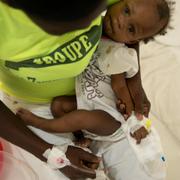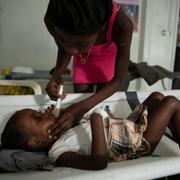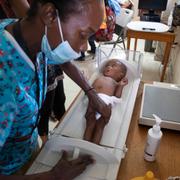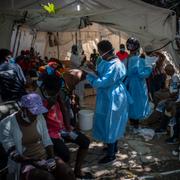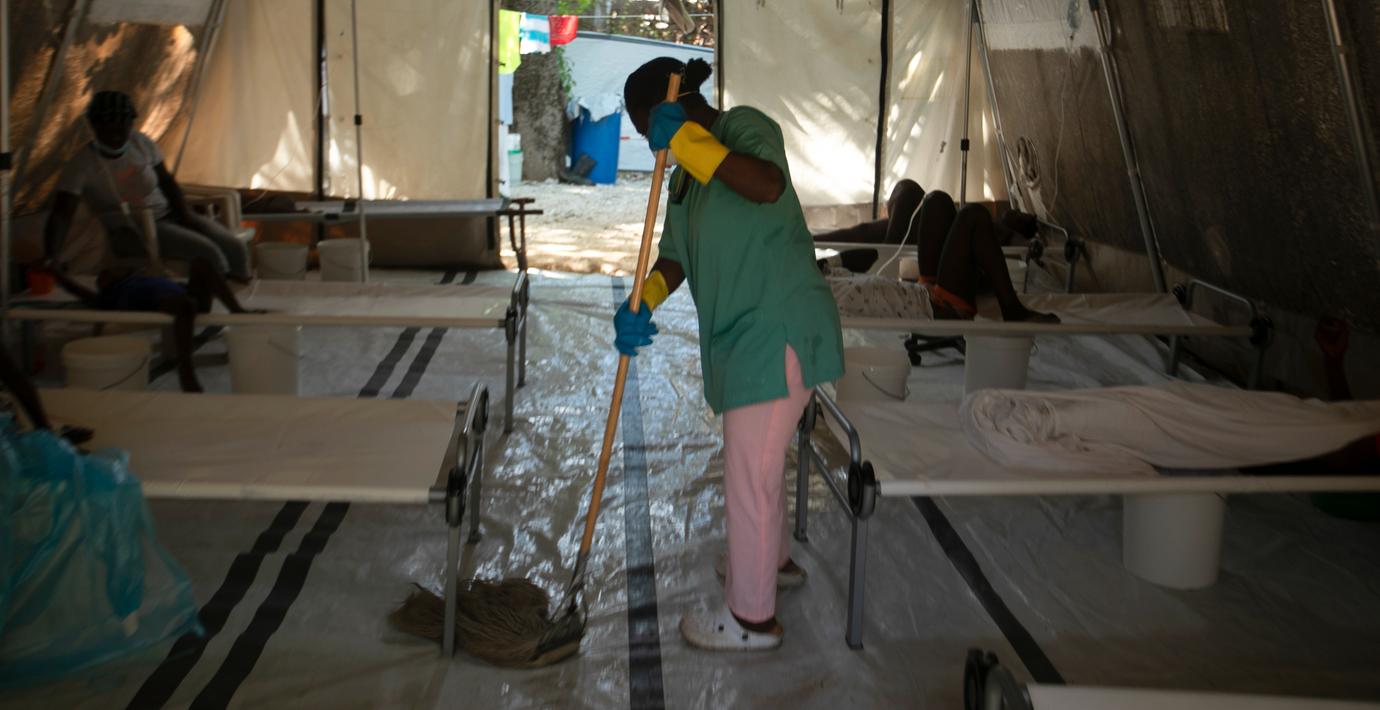
Koleran tillbaka i Haiti – de flesta sjuka är barn
De senaste två veckorna har minst 36 personer dött till följd av kolera i Haiti, enligt en rapport från FN-organet Ocha. Första fallet upptäcktes 2 oktober i huvudstaden Port-au-Prince och nu har 655 misstänkta fall av smitta upptäckts.
Över hälften av de insjuknade under 14 år, enligt Ocha.
– Det är så många barn bland de sjuka och alla är undernärda, säger läkaren Marie Marcelle Deschamps, som jobbar på ett koleracenter i huvudstaden, i ett uttalande från FN.
Ett stort utbrott har även lokaliserats till ett fängelse i huvudstaden. Där har 14 personer dött av misstänkt kolera. Sjukdomen härjade på Haiti efter den kraftiga jordbävningen 2010 till 2019. Då dog 10 000 personer.
Läs mer
bakgrund
Kolerautbrottet på Haiti
Wikipedia (en)
The 2010s Haiti cholera outbreak is the first modern large-scale outbreak of cholera—a disease once considered beaten back largely due to the invention of modern sanitation. The disease was reintroduced to Haiti in October 2010, not long after the disastrous earthquake earlier that year, and since then cholera has spread across the country and become endemic, causing high levels of both morbidity and mortality. Nearly 800,000 Haitians have been infected by cholera, and more than 9,000 have died, according to the United Nations (UN). Cholera transmission in Haiti today is largely a function of eradication efforts including WASH (water, sanitation, and hygiene), education, oral vaccination, and climate variability. Early efforts were made to cover up the source of the epidemic, but thanks largely to the investigations of journalist Jonathan M. Katz and epidemiologist Renaud Piarroux, it is widely believed to be the result of contamination by infected United Nations peacekeepers deployed from Nepal. In terms of total infections, the outbreak has since been surpassed by the war-fueled 2016–2021 Yemen cholera outbreak, although the Haiti outbreak is still one of the most deadly modern outbreaks. After a 3 year hiatus, new cholera cases reappeared in October 2022.
bakgrund
Kolera
Wikipedia (en)
Cholera is an infection of the small intestine by some strains of the bacterium Vibrio cholerae. Symptoms may range from none, to mild, to severe. The classic symptom is large amounts of watery diarrhea that lasts a few days. Vomiting and muscle cramps may also occur. Diarrhea can be so severe that it leads within hours to severe dehydration and electrolyte imbalance. This may result in sunken eyes, cold skin, decreased skin elasticity, and wrinkling of the hands and feet. Dehydration can cause the skin to turn bluish. Symptoms start two hours to five days after exposure.Cholera is caused by a number of types of Vibrio cholerae, with some types producing more severe disease than others. It is spread mostly by unsafe water and unsafe food that has been contaminated with human feces containing the bacteria. Undercooked shellfish is a common source. Humans are the only known host for the bacteria. Risk factors for the disease include poor sanitation, not enough clean drinking water, and poverty. Cholera can be diagnosed by a stool test. A rapid dipstick test is available but is not as accurate.Prevention methods against cholera include improved sanitation and access to clean water. Cholera vaccines that are given by mouth provide reasonable protection for about six months. They have the added benefit of protecting against another type of diarrhea caused by E. coli. By 2017 the US Food and Drug Administration (FDA) had approved a single-dose, live, oral cholera vaccine called Vaxchora for adults aged 18–64 who are travelling to an area of active cholera transmission. It offers limited protection to young children. People who survive an episode of cholera have long-lasting immunity for at least 3 years (the period tested.)The primary treatment for affected individuals is oral rehydration salts (ORS), the replacement of fluids and electrolytes by using slightly sweet and salty solutions. Rice-based solutions are preferred. Zinc supplementation is useful in children. In severe cases, intravenous fluids, such as Ringer's lactate, may be required, and antibiotics may be beneficial. Testing to see which antibiotic the cholera is susceptible to can help guide the choice.Cholera continues to affect an estimated 3–5 million people worldwide and causes 28,800–130,000 deaths a year. The most recent of seven cholera pandemics and associated outbreaks, since the early 19th century, started about 1961. As of 2010, it is rare in high income countries. Children are mostly affected. Cholera occurs as both outbreaks and chronically in certain areas. Areas with an ongoing risk of disease include Africa and Southeast Asia. The risk of death among those affected is usually less than 5%, given improved treatment, but may be as high as 50% without such access to treatment. Descriptions of cholera are found as early as the 5th century BC in Sanskrit. In Europe, cholera was a term initially used to describe any kind of gastroenteritis, and was not used for this disease until the early 19th century. The study of cholera in England by John Snow between 1849 and 1854 led to significant advances in the field of epidemiology because of his insights about transmission via contaminated water.
Omni är politiskt obundna och oberoende. Vi strävar efter att ge fler perspektiv på nyheterna. Har du frågor eller synpunkter kring vår rapportering? Kontakta redaktionen
